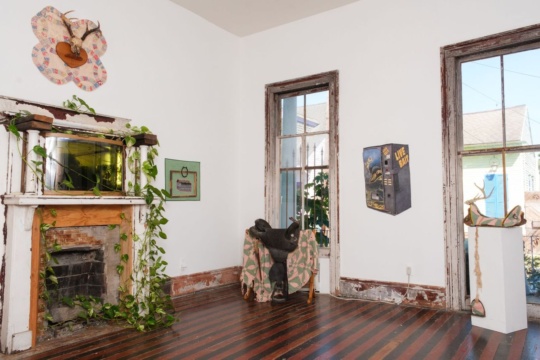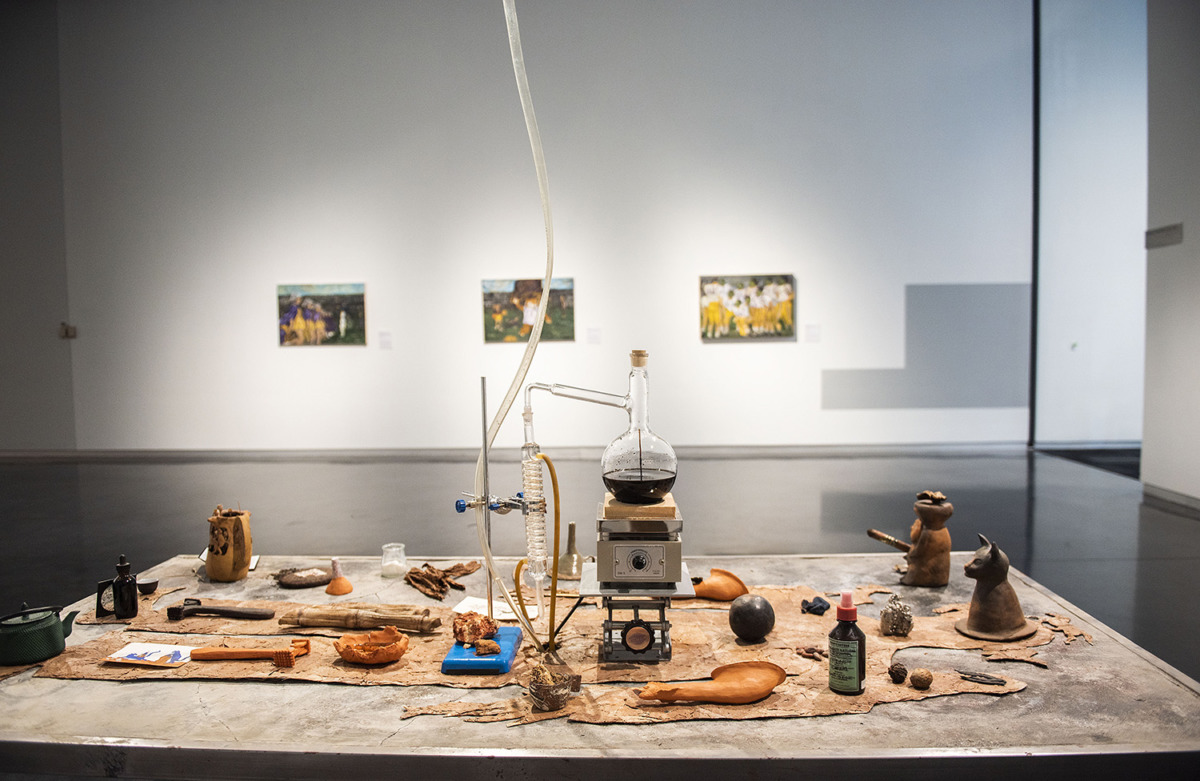
Candice Lin compiles a powerful past, present, and future analysis with her solo exhibition, The Agnotology of Tigers, currently on view at the LSU Museum of Art. The works presented in the exhibit are a continuation of Lin’s exploration of the Chinese laborers exploited in the American South through symbolic materials and the historical references that they contain.
There are multiple ways to enter the exhibition, as the perspective of the work shifts depending on the direction one enters from. These shifts are an unexpected nod to the agnotological focus of the exhibit— agnotology being the study of culturally-induced ignorance or doubt. On one side, there is the presentation of raw materials required for production, and on the other side of the wall, the aftermath of said production.
The focal point of The Agnotology of Tigers is La Chirada China (Tobacco Version), 2019, an installation of a silhouette body made of dried tobacco leaves, displayed on a steel examination table alongside ephemeral objects. The installation’s title is based on the Cuban-Chinese gambling game of the same name, which is visually similar to the classic US game of Operation. Situated in the center of the room, the tobacco body is a semblance of a stereotypical Chinese “coolie,” which is a derogatory term originating from South India that was used to describe low-wage laborers of South Asian and East Asian descent. Lin intentionally uses the term to address the indentured Asian labor brought over during the 19th century to sustain plantation-based economies in the Western Hemisphere, with a specific focus on Chinese indentured laborers.
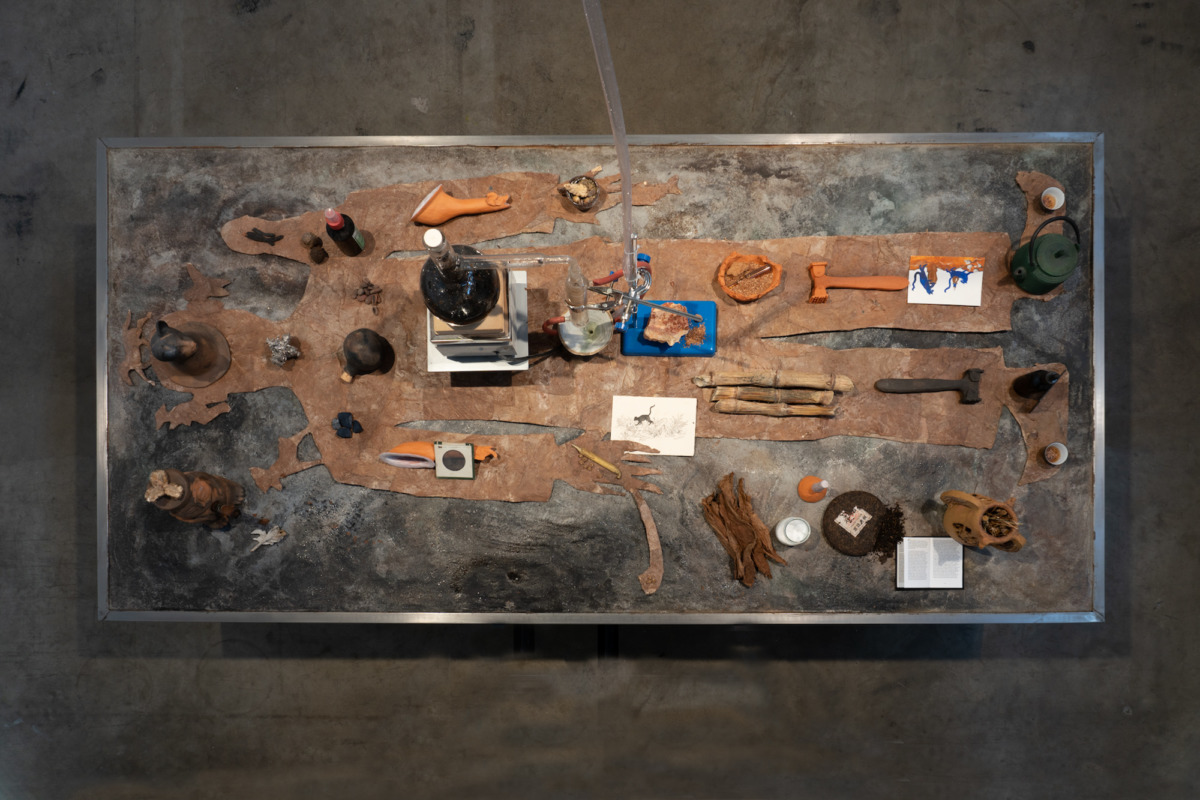
These laborers were largely silent victims during the post-antebellum period as plantation owners scrambled to replace their newly emancipated Black laborers with the cheap labor of South and East Asian indentured workers. Southern planters found a loophole to the Anti-Coolie Act of 1862, created by the California State Legislature to appease white workers who did not want to compete with the cheaper labor of Chinese immigrants during the California gold rush, by arguing that Chinese laborers were “voluntary” and had left Cuba after their contracts expired. This practice of replacing slave labor with “coolie” labor was prevalent in the American South, Latin America, the Caribbean, and former British colonies in Africa and Asia. Although traders, legislators, and planters gave this “cheap labor” the impression of being under contract, consensual, paid, and intended to be temporary, it was an illusory indentureship rife with abuse, deception, violence, kidnapping, and high mortality rates.
On top of the laborer’s tobacco silhouette are multi-sensory materials that speak to the cultural history of these indentured workers on plantations in the American South. Lin is mindful in her acknowledgment of other industrial crops that have directly influenced forced migrations, as evidenced by the strategic placement of sugarcane, indigo, and cotton along the body. The most prominent object is the distillation system (repetitively distilling a tincture of tobacco, sugar, tea, indigo, and poppy) positioned on the abdomen of the body. Some of the other materials include clay from California and the Dominican Republic, cacao seeds, opium poppy pods, a teapot, ackee, sage, drawings, anadenanthera, dong quai, and ceramic objects that speak to other moments in Lin’s career.

The toxic conditions in which the workers labored are evoked when the distillation system reaches its boiling point, as evidenced by the visceral scent of the combined materials. After a set time, the collected distillate is transported via pumps through an overhead translucent pipe network from the bucket under the table, through another bucket overhead that is flush against the dividing wall, then over the dividing wall onto the unfired clay scene. Then, the remaining, undeposited liquid flows backward into the two previous buckets. The audio effect is more distinct due to the spatial layout and feels disruptive to the otherwise silent exhibition. Still, this disruption motivates the viewer to pause, reflect, and take in the work from a deeper observational standpoint. The entire process takes about twenty minutes. Then, the production begins anew. It is as though Lin is encouraging us, through all these inferences, to absorb for ourselves what remains, both in terms of historical retelling and also as a result of extraction, particularly racial and environmental extraction.

The entirety of the body being made of tobacco, as well as the use and placement of tobacco in the installation, alludes to the “coolie” indentured laborers brought to tobacco plantations in Cuba. Beginning in 1840, these laborers worked alongside enslaved Africans as neither free nor enslaved peoples. The silhouette’s material also highlights tobacco’s identity as a popular crop and trade item, as “coolie” laborers were brought from China, Java, and India by the Dutch to work on tobacco plantations in Sumatra in the 1860s. The herbs and plants are fragments of the geographical regions that Chinese indentured laborers experienced, with a special note to ackee, anadenanthera, and dong quai, which can all be used to either heal or harm. Opium was widely used as a form of social control, given to laborers to dull their pain and symptoms of disease. Taking opium was encouraged both by the merchants who transported the laborers and by the planters they toiled for, being distributed or withheld at whim.
This is the second time Lin’s La Charada China (Tobacco Version) has been installed, with the first being at Art Basel Miami Beach in 2019. In Baton Rouge, the historical significance of the work is resounding, given that the LSU campus grounds were once home to the Gartness Plantation. The Student Health Center, built in 1938, is directly atop a slave cemetery. The historical significance of Chinese workers being brought to the South to work exemplifies the lengths that white supremacy will go in its justification of “otherness” and presumed racial superiority, which is what agnotology is all about.
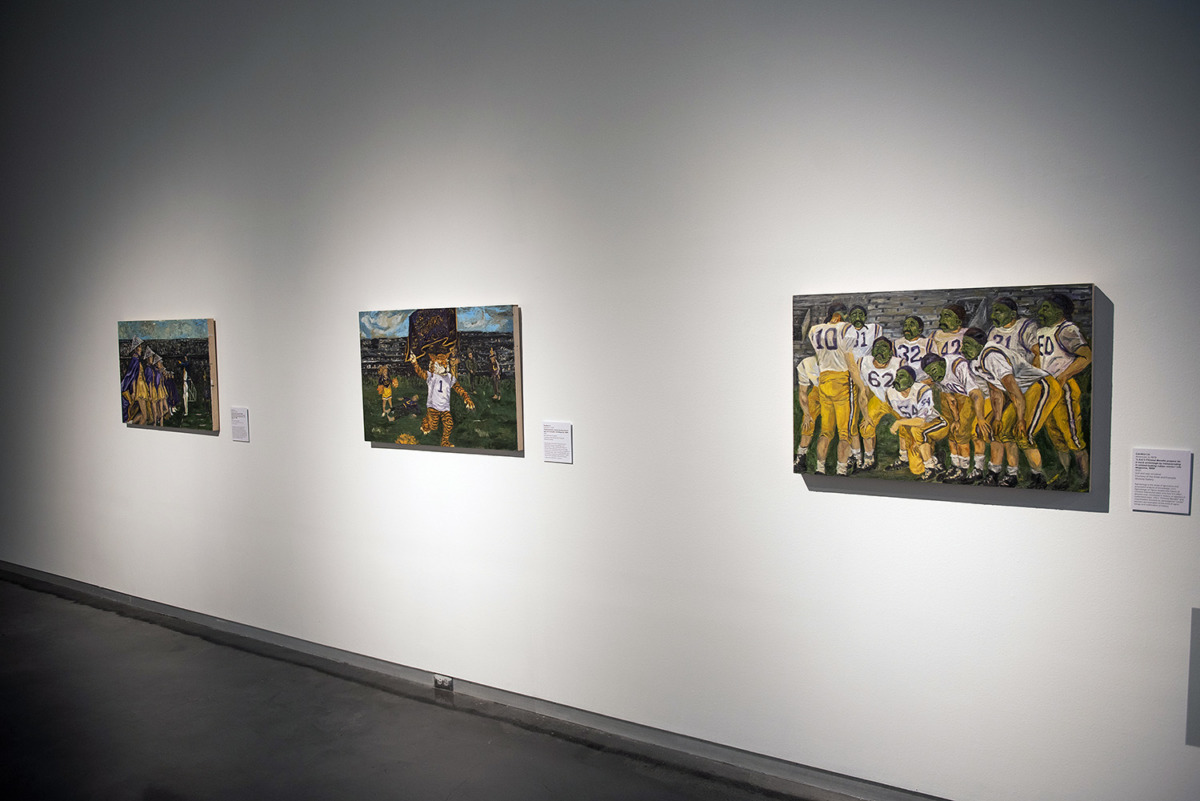
On the wall adjacent to one of the entryways, Lin engages Chinese stereotypes and turns them on their perpetrators in three works depicting Chinese prowess, directly confronting the use of problematic language in LSU athletics through anthropomorphic visions of LSU football players as “Chinese bandits” and cheerleaders dressed as “coolie” laborers. These three works are based on archival images from LSU. Since 1958, the LSU Tigers’ defense has been referred to as the “Chinese Bandits,” a name given to them by head coach Paul Dietzel who used the term to describe the team’s ferociousness and recklessness. Dietzel believed that what the defense team lacked in experience and skill, they made up for in tenacity and toughness. He named the team after characters from a Terry and the Pirates comic strip, which described the “Chinese bandits” as “the most vicious people in the world.” The intentional erasure of such racialized violence against Chinese laborers gives way to justification for their subsequent mistreatment and exposure to toxic substances and work environments.
In collaboration with students from the LSU School of Art, Lin provides a response to the after, with a dry clay wasteland of flora, fauna, and debris including an alligator, pelican, crab, fish, skeletal remains, plants, chain links, barbed wire, two empty, cracked barrels, a face mask, and other human waste, scattered around a cracked barrel through which the deposited distillate seeps, rendering the barrel a yellowed discoloration amidst the skeletal relics. A sly nod to the limits of production is affirmed by a power toggle switch that has been positioned in the corner of the desiccated clay scene, and, of course, is always on.
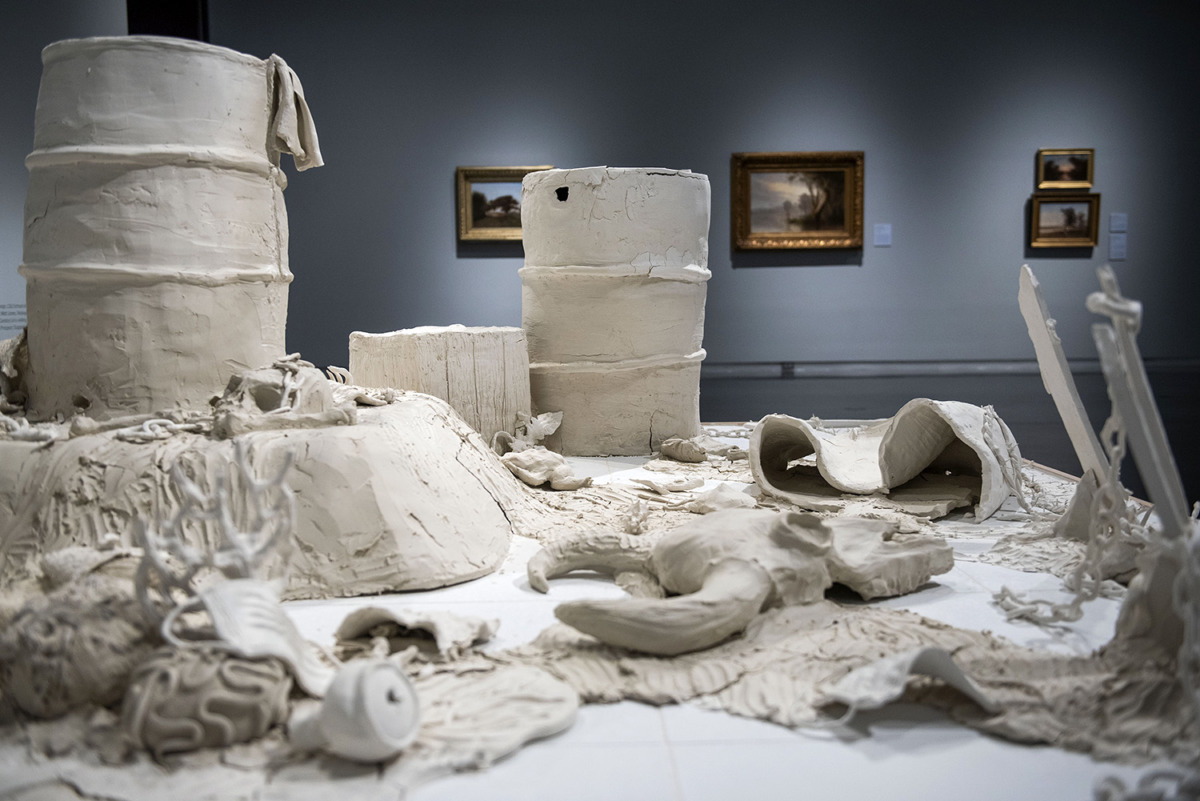
While the Agnotology of Tigers is provocative in its attempt to expand the viewer’s awareness and knowledge of the subject at hand, it is left to the viewer to research the hidden history of “coolie” labor, which is fragmented with sparse details. Even Lin’s use of certain materials is speculative, placing her own agnotology onto the objects that would have been associated with the Chinese laborers’ lived experiences, subsequently blurring the line between real and imagined artifacts. The lives of Chinese laborers in the South were directly affected by the already enforced power dynamics of plantation economies and systems of control. In efforts to maintain the power and wealth dynamics of planters prior to the Civil War, “coolie” labor was brought in alongside pre-existing exploitative labor practices, including sharecropping and the enforcement of Black Codes. This means that in the South, these Chinese workers either worked alongside or, incidentally, in direct competition to enslaved Black workers.
Candice Lin bears witness to Southern labor histories that are still in the early stages of being reckoned with, and, in doing so, the audience becomes witnesses and must reckon with them too. We can draw inferences and reckon with our relationships to the visual record on display, by slowing down the viewing process and leaving space for criticism and curiosity.
Candice Lin: The Agnotology of Tigers is on view at the LSU Museum of Art through March 20, 2022.
This exhibition is a collaboration between the LSU College of Art & Design, the LSU School of Art, and the LSU Museum of Art. The porcelain sculpture in the exhibit was created on site with LSU School of Art students Kyra Jackson, Matt Jones, Nickeyia Johnson, Cecelia Moseley, Gillian Harper, Lu Colby, Paul Acevedo Gomez, Thras Kalaitzidis, and Ali Saunders during Candice Lin’s visiting artist workshop. This sculpture will be eroded over time by the distillation system of La Charada China (Tobacco Version).



